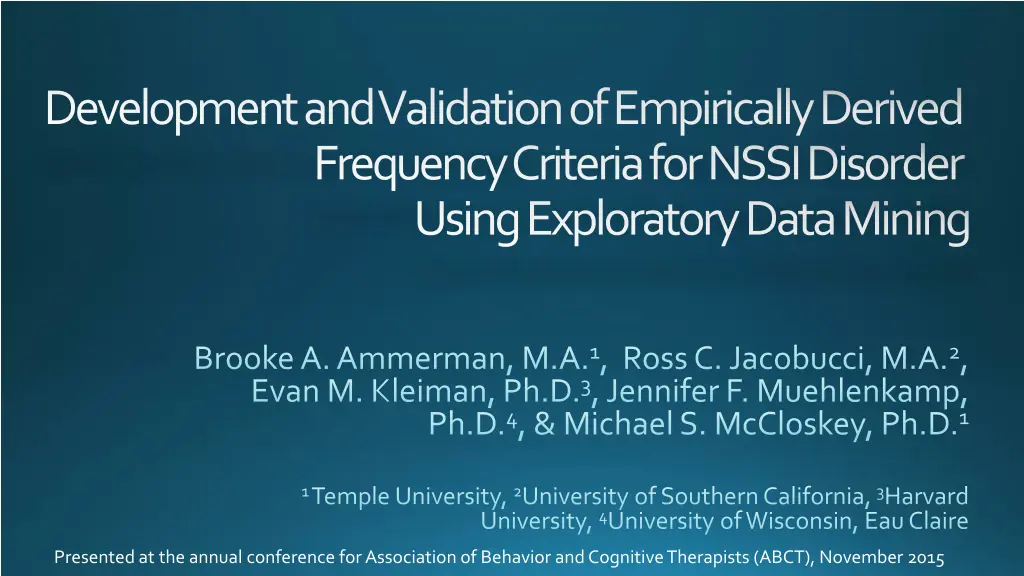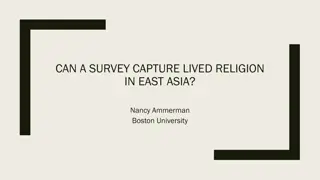
Validation of NSSI Disorder Frequency Criteria
This study focuses on the development and validation of empirically-derived frequency criteria for NSSI disorder using exploratory data mining. It explores the engagement in NSSI on multiple days and the associated reasons and preconditions. The research aims to differentiate between pathological NSSI and typical behavior based on cognitive-affective deficits and psychopathology symptomology using Structural Equation Modeling Trees (SEM Trees) method.
Download Presentation

Please find below an Image/Link to download the presentation.
The content on the website is provided AS IS for your information and personal use only. It may not be sold, licensed, or shared on other websites without obtaining consent from the author. If you encounter any issues during the download, it is possible that the publisher has removed the file from their server.
You are allowed to download the files provided on this website for personal or commercial use, subject to the condition that they are used lawfully. All files are the property of their respective owners.
The content on the website is provided AS IS for your information and personal use only. It may not be sold, licensed, or shared on other websites without obtaining consent from the author.
E N D
Presentation Transcript
Development and Validation of Empirically Derived Frequency Criteria for NSSI Disorder Using Exploratory Data Mining Brooke A. Ammerman, M.A.1, Ross C. Jacobucci, M.A.2, Evan M. Kleiman, Ph.D.3, Jennifer F. Muehlenkamp, Ph.D.4, & Michael S. McCloskey, Ph.D.1 1 Temple University, 2University of Southern California, 3Harvard University, 4University of Wisconsin, Eau Claire Presented at the annual conference for Association of Behavior and Cognitive Therapists (ABCT), November 2015
NSSI Disorder NSSI Disorder as a disorder for future study in DSM-5 A: Engage in NSSI on five or more separate days in past 12 months B: For one of the following reasons: relieve negative thoughts/feelings; resolve interpersonal problems; positive feeling/emotion C: Associated with negative thoughts/feelings or interpersonal problem immediately prior to behavior, preoccupation with behavior, or frequent urge
Study Background Previous research support both B and C 1, 2, 3 Limited evidence for frequency criterion (A) Early research proposed indicative of own disorder if five or more acts 4 8.7% with 5+ did not meet B or C; 74% meeting full criteria had 11+ acts5 4.6% with 5+ with only 2.6% meeting full criteria 6 Over 80% with 5+ with 71.8% meeting full criteria 7 One way to explore the validity of the A criterion is through Exploratory Data Mining (EDM) 8 1 Muehlenkamp, Brausch, Quigley, & Whitlock, 2013; 2 Nock & Prinstein, 2005; 3 Nock, Prinstein & Sterba, 2009; 4 Favazza & Rosenthal, 1990; 5 Zetterquist et al., 2013; 6 Andover, 2014; 7 Washburn, Potthoff, Juzwin, & Styer, 2015; 8 McArdle & Ritschard, 2013
Current Study Use specific EDM method, Structural Equation Modeling Trees (SEM Trees) NSSI frequency that optimally discriminate pathological NSSI from typical behavior Two separate models Cognitive-Affective Deficits Psychopathology Symptomology
Data Analysis Tried three different statistical methods across two different latent constructs aimed to indicate pathological NSSI SEM Trees DT with explicitly estimating factor scores DT using summed scores Used two separate factor models based on risk factor literature
Method 3,559 undergraduate students (63% female, M age = 20.78, 61% Caucasian) 428 participants (11.72%) 1+ NSSI past year 156 (4.27%) 5+ NSSI past year Suicidal T &B Suicidal T &B Depression Depression Cognitive- Affective Deficits Anxiety Psychopathology Symptomology Emotion Dysregulation Borderline Symptomology Emotion Reactivity Disordered Eating Model 2 Model 1 Alcohol Abuse
Model 1:Cognitive-Affective Confirmatory Factor Analysis Unstandardized Standardized Depression 1 .66 Suicidality .13 .41 Emotion Dysregulation 6.51 .79 Emotion Reactivity 5.07 .75 ?2 (2) = 71, p < 0.001, with CFI = 0.97, RMSEA = 0.12 (95% CI: 0.10, 0.15), and SRMR = 0.03
N= 3559, LR = 518.5 (ddf = 12) Total NSSI Act >= 0.5 No Yes l2 = 0.111 l3 = 7.343 l4 = 5.653 e1 = 8.929 e2 = 0.526 e3 = 178.597 e4 = 151.429 varF1 = 5.392 meanx1 = 5.068 meanx2 = 1.526 meanx3 = 82.103 meanx4 = 27.239 N = 3131 N= 428, LR = 57.4 (ddf = 12) Total NSSI Act >= 5.5 No Yes l2 = 0.137 l3 = 4.918 l4 = 4.124 e1 = 8.906 e2 = 0.792 e3 = 195.517 e4 = 163.572 varF1 = 9.636 meanx1 = 7.194 meanx2 = 2.109 meanx3 = 92.82 meanx4 = 35.669 N = 289 N= 139, LR = 24.2 (ddf = 12) Total NSSI Act >= 70 Yes No l2 = 0.1 l3 = 4.636 l4 = 3.916 e1 = 11.288 e2 = 0.748 e3 = 243.691 e4 = 85.366 varF1 = 16.914 meanx1 = 10.061 meanx2 = 2.492 meanx3 = 103.456 meanx4 = 40.31 N = 114 l2 = 0.144 l3 = 5.372 l4 = 4.478 e1 = 9.318 e2 = 0.367 e3 = 138.3 e4 = 138.3 varF1 = 10.594 meanx1 = 8.898 meanx2 = 3.12 meanx3 = 108.92 meanx4 = 46.272 N = 25 Model 1: Cognitive Affective SEM Tree
Model 1: Cognitive Affective Decision Trees using Factor Scores Total NSSI Act < 0.5 -0.05896 Total NSSI Act < 5.5 0.30930 0.68510
Model 2: Psychopathology Confirmatory Factor Analysis Unstandardized Standardized Depression 1 .74 Suicidality .77 .59 Borderline Personality 1.06 .81 Disordered Eating .62 .49 Anxiety .68 .53 Alcohol Abuse .32 .25 ?2 (9) = 343, p < .001, with CFI = 0.93, RMSEA = 0.10 (95% CI: 0.09, 0.11), SRMR = 0.05
N= 3515, LR = 578 (ddf = 18) Total NSSI Act >= 0.5 Yes No l2 = 0.138 l3 = 0.791 l4 = 0.215 l5 = 2.502 l6 = 0.482 e1 = 7.176 e2 = 0.46 e3 = 3.594 e4 = 1.348 e5 = 132.879 e6 = 30.906 varF1 = 7.146 meanx1 = 5.068 meanx2 = 1.531 meanx3 = 2.923 meanx4 = 1.238 meanx5 = 48.776 mean6 = 6.38 N = 3093 N= 422, LR = 79.6 (ddf = 18) Total NSSI Act >= 5.5 No Yes l2 = 0.194 l3 = 0.832 l4 = 0.173 l5 = 2.681 l6 = 0.307 e1 = 10.527 e2 = 0.682 e3 = 3.342 e4 = 1.838 e5 = 124.537 e6 = 47.977 varF1 = 7.762 meanx1 = 7.101 meanx2 = 2.104 meanx3 = 4.988 meanx4 = 1.676 meanx5 = 53.653 mean6 = 8.534 N = 286 N= 136, LR = 42.1 (ddf = 18) Total NSSI Act >= 19.5 No Yes l2 = 0.143 l3 = 0.419 l4 = 0.218 l5 = 2.913 l6 = -0.362 e1 = 13.186 e2 = 0.617 e3 = 4.459 e4 = 1.316 e5 = 56.326 e6 = 45.798 varF1 = 16.516 meanx1 = 9.874 meanx2 = 2.431 meanx3 = 6.902 meanx4 = 2.174 meanx5 = 58.498 mean6 = 8.915 N = 74 l2 = 0.106 l3 = 0.363 l4 = 0.17 l5 = 3.387 l6 = -0.019 e1 = 12.80 e2 = 0.649 e3 = 6.155 e4 = 2.414 e5 = 119.58 e6 = 18.592 varF1 = 11.021 meanx1 = 9.945 meanx2 = 2.813 meanx3 = 6.598 meanx4 = 2.772 meanx5 = 55.862 mean6 = 5.906 N = 62 Model 2: Psychopathology SEM Tree
Model 2: Psychopathology Decision Trees using Factor Scores Total NSSI Act < 0.5 -0.07796 Total NSSI Act < 5.5 0.41710 0.89600
Model Summary Consistent result for two splits O vs. 1 NSSI act in past year 5 vs. 6 NSSI acts in pat year Weak evidence for third split Main criteria for model acceptance: theoretical explanation + parsimony of models
Group Comparisons No NSSI (n = 3137) M (SE) 1-5 NSSI acts (n = 286) M (SE) 6+ NSSI acts (n = 136) M (SE) 2 F - value .10 1.52 (.01) a 2.11 (.05) b 2.61 (.07) c 175.37*** Suicidality .07 5.07 (.07) a 7.16 (.24) b 9.92 (.34) c 127.41*** Depression .05 82.10 (.39) a 96.80 (1.27) b 104.44 (1.84) c 97.44*** Emotion Dysregulation .03 27.42 (.36) a 35.88 (1.25) b 40.90 (1.79) b 45.82*** Emotion Reactivity .08 2.95 (.06) a 5.01 (.20) b 6.76 (.29) c 126.91*** Borderline Personality .03 1.25 (.03) a 1.68 (.09) b 2.43 (.13) c 46.69*** Disorder Eating .02 48.85 (.27) a 53.76 (.93) b 57.30 (1.36) b 29.83*** Anxiety .02 6.15 (.12) a 8.55 (.41) b 7.59 (.59) b 18.29*** Alcohol Abuse
Discussion One of the first studies: To explicitly look at criterion A for NSSI Disorder, Use of Exploratory Data Mining Findings suggest there are three distinct groups Those who do not engage in NSSI Those who seldom engage in NSSI (1-5 times per year) Those who frequently engage in NSSI (6+ times per year) Implications for NSSI Disorder
The study was supported by funding for the National Institute of Mental Health (MH084904) to Michael McCloskey and Emil Coccaro and the National Institute on Aging Grant (T32AG0037) to Ross Jacobucci Thank you to my co-authors: Ross Jacobucci, Evan Kleiman, Jennifer Muehlenkamp, and Michael McCloskey Acknowledgements






















